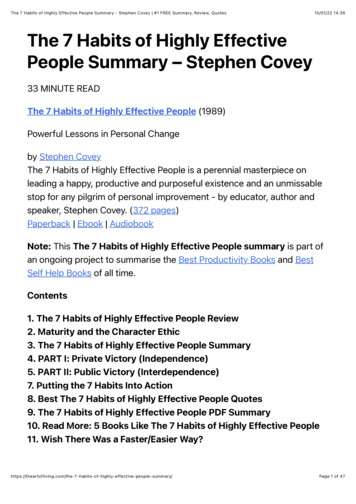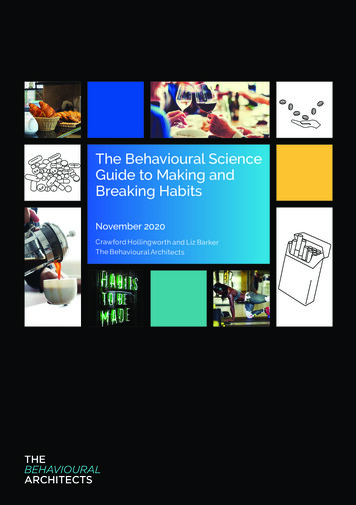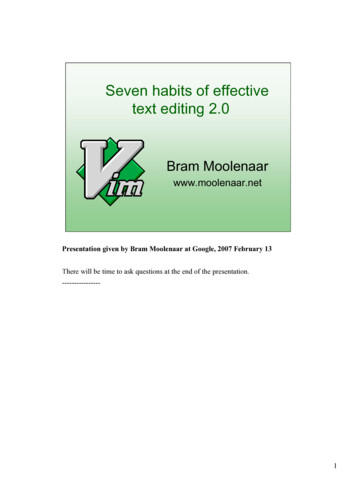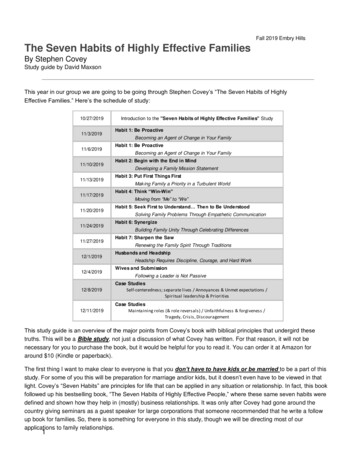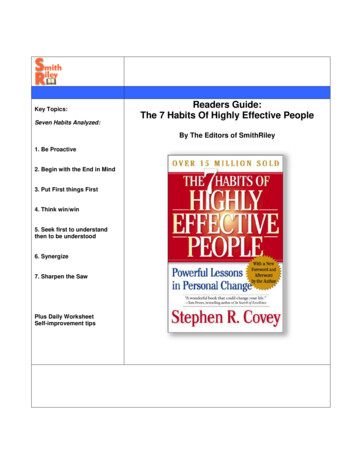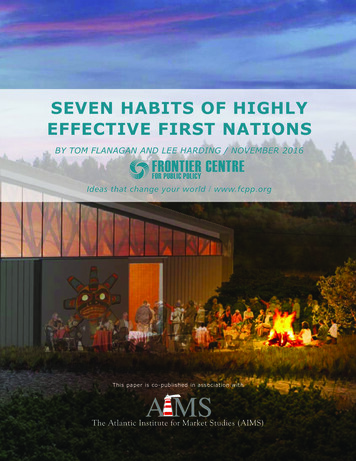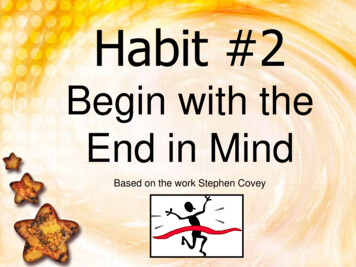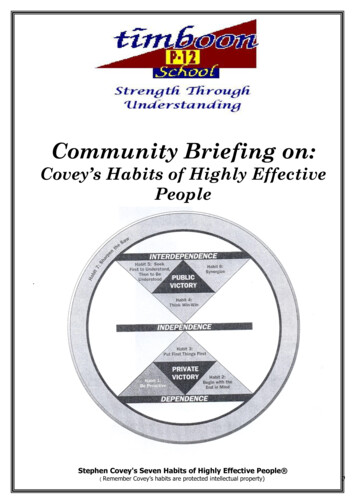
Transcription
The Seven Habits of Highly Effective CounselorsA Guide to Jewish Leadershipfor Summer Camp Counselors-in-TrainingBy Erin Ellis Mason!"!
Table of ContentsTable of Contents2Rationale5Letter to the Educator11Unit I – Starting from the Inside OutUnit Understandings, Goals, Objectives14Suggested Activities16MM Creating a CIT Brit19MM What color is your tallit?20Scripted Lesson23Resources27Unit II – Being True to MyselfUnit Understandings, Goals, Summary57Habit 1 – Be ProactiveEssential Questions, Objectives, Summary of Habit59Suggested Activities62Scripted Lesson65Habit 2 – Begin with the End in MindEssential Questions, Objectives, Summary of Habit68Suggested Activities72MM CIT Mission Statement74Habit 3 – Putting First Things FirstEssential Questions, Objectives, Summary of Habit76Suggested Activities81Resources!84#!
Unit III – Being Part of a TeamUnit Understandings, Goals, Summary106The Relationship Bank AccountEssential Questions, Objectives, Summary of Idea108Suggested Activities109Habit 4 – Thinking Win/WinEssential Questions, Objectives, Summary of Habit113Suggested Activities116Scripted Lesson118Habit 5 – Seek First to Understand, Then to Be UnderstoodEssential Questions, Objectives, Summary of Habit123Suggested Activities126Habit 6 – SynergizeEssential Questions, Objectives, Summary of Habit129Suggested Activities131MM Puzzle Pieces132Resources133Unit IV – Taking Care of MyselfUnit Understandings, Goals142Habit 7 – Sharpening the Saw143Suggested Activities145MM Scripted Lesson – Bringing It All Together147Resources152Appendix!Essential Questions, Objectives, Summary of Habit156 !
Annotated Bibliography!176%!
RationaleThis curriculum guide focuses on leadership growth and development throughthe application of The Seven Habits of Highly Effective People by Stephen R. Coveyto Biblical leadership. Midrash, modern commentary and interpretation, selfreflection and on-the-job training all combine to help participants learn how to bethe best people they can be, and, in turn, how to be the best leaders they can be.Other writing about leadership is also referenced as leadership is characterized anddescribed when it is supported by or tied to a Jewish source or teaching.Counselors-in-training at many Jewish summer camps are entering 12th grade.This is a time filled with milestones and transitions, as they prepare to apply tocollege and take on new leadership roles at camp, in youth group, at school, and inextracurricular activities. They are in a constant process of self-exploration. A teenat this stage is examining his or her own experiences. According to James Fowler’sStages of Faith (1995), “as contradictions emerge between ideal theologicalteachings and real life and the practice of these teachings [teens] begin to seekwhat is true for them as individuals ”1 Teens begin to be introspective, figuring outwhat is important to them as they look toward the next stage in their !!!!!!!!!!!!"!Fowler,!James. “Stages of Faith.” Adapted by Diane Tickton Schuster from Focus, May 2004.&!
whether that is attending college or beginning a career.2 Exploring Jewishleadership allows them also to explore their own leadership. Through analyzing thedevelopment, successes, and challenges of Biblical leaders through the lens of theSeven Habits, teens can develop an ability to look critically at their own leadershipand lifestyle. They can analyze their own behavior, look inside themselves for theanswers, and, having identified principles on which they would like to center theirlives, make decisions based on these principles. They will understand what it meansto take responsibility for their actions, think about the choices they make, and viewtheir relationships in a way that will sharpen their focus.These teenage CITs are at a critical stage in their lives in which reflectionand questioning happens on a regular basis. Whether or not they do so consciously,they are continually making decisions about their lives: which peer group to join,into which pressures to succumb, how to spend their time. Learning about theirability to lead effectively can only strengthen their ability to make good decisionsand to lead better lives as Jews. !Throughout their summer as counselors-in-training, these teens will learnlessons that are applicable both to their lives at camp and to the lives to whichthey return when the summer ends. They will learn how to lead, who they are !!!!!!!!Diane Tickton. “Exploring Identities: Tasks of Emerging Adulthood.” Based on EmergingAdulthood: The Winding Road from Late Teens Through the Twenties by Jeffrey Jensen Arnett (NewYork: Oxford University Press, 2004).#!Schuster,!'!
leaders, what their personal leadership styles are. Stephen R. Covey’s Seven Habitsof Highly Effective People help the participant learn about his or her own leadershipthrough learning about him or herself. Covey’s son, Sean, realized this too; he haswritten a book specifically for teens called The Seven Habits of Highly EffectiveTeens, referenced throughout this guide.Playing a leadership role at camp, being surrounded by other Jews alsoexploring their identities, and learning together – both in structured learning timetogether and throughout daily life at camp – these learners will continue tounderstand their place in the long line of the Jewish people. The Habits speak tothem about who they are as Americans; the integration created by layering uponthis teaching Biblical leadership and Jewish tradition helps them learn about whothey are as American Jews.This guide begins with the teaching of The Leadership Character Model.Turknett and Turknett (2005) state that integrity is “the incorruptible foundationauthentic leadership must rest on.”3 Integrity is like the base of a scale; theplatforms that balance the scale are respect and responsibility. In Jewish tradition,we also learn that integrity (tememut), respect (kavod), and responsibility (achrayut)are keys to effective leadership. For example, Martin Buber teaches that !!!!!!!!!!!!! !Turknett,Robert L. and Carolyn N. Turknett. “The Leadership Character Model.” Decent People:How to Lead with Character at Work and in Life. Davies-Black Publishing, 2005, 27-46. P. 29.!(!
should “Do what they say, and say what they mean,” providing insight into what itmeans for a leader to have integrity.After this introduction to leadership, this guide moves on to an in-depthexploration of the Seven Habits and Biblical leaders. The first three of the SevenHabits, known as Private Victories, focus on the participant as an individual: beproactive, begin with the end in mind, and put first things first. Joseph stands outas a proactive leader who can also teach us about putting first things first. Thestory of creation is a wonderful example of how God began with the end in mind.These Biblical narratives are explored through the lens of the Habits and throughthe use of text study (including Torah and midrash) and real-world applications,including the writing of a CIT mission statement.Only after the participant has learned about the Private Victories can he orshe move on to the Public Victories, which focus on relationships with others. Thisunit begins with The Relationship Bank Account, taught through the story of Esther,who made more deposits than withdrawals to make sure she had a substantialbalance before withdrawing from the account she held with the king. The narrativeof Moses provides a paradigm through which the habits in Public Victories can beunderstood: Win/Win thinking is used on a number of occasions, but so are thenegative ways to approach situations of conflict; seeking first to understand, thento be understood is studied through examining Moses’ relationship with the!)!
Israelites; synergizing is used when Yitro observes Moses as judge and suggests away for Moses to be more effective in that position.Concluding this curriculum guide is the seventh habit, which focuses on takingcare of one’s self. It is important that a leader refresh her mind, body, soul andheart. Our tradition has a built-in way to do this: Shabbat can be used tounderstand how we can take care of ourselves. A synthesis activity of creating theirown book of modern commentary on the habits, the Biblical leadership studied, andthe participants’ experiences with leadership at camp this summer brings thecurriculum guide to a close.Driving this guide are the following Enduring Understandings:1. Biblical models of leadership can shape how we think about our ownleadership.2. Modern writing about leadership, especially Stephen Covey’s Seven Habits ofHighly Effective People, provides a congruous paradigm for understandingBiblical leadership, often corresponding to the way in which our Biblicalleaders related to others, acted with forethought, and set priorities.3. There are also instances when Biblical leadership is in tension with the SevenHabits paradigm, thus presenting challenges to our relationship with theseBiblical leaders.Biblical leadership is often congruous with modern thinking about leadership.By critically analyzing Biblical leadership and exploring the ways in which theseleaders were effective and not so effective, learners can develop a relationship withthem. By looking to Biblical leaders for direction on how to lead, learners can!*!
establish or strengthen a connection to the Bible and our heritage. Our Biblicalleaders have much to teach us about effective and ineffective leadership. It isinteresting to note that when the Biblical leaders are using the Seven Habits, theirleadership is successful. When times are challenging for the Biblical leaders, theyare often not using the habits.!" !
Dear Educator,When the director of the Rhea Hirsch School of Education assigned The SevenHabits of Highly Effective People as summer reading in preparation for ourLeadership and Management course, I was shocked and a bit taken aback. I did notunderstand why we were reading a self-help book. It was only after reading thebook and learning about it with my classmates and professor that I realized that itprovides a new, effective, and exciting paradigm about living and leading. I alsofound it compelling when taught in conjunction with Jewish sources and decided thatit could be appropriate and beneficial if taught as part of a leadership curriculumfor high school students.The Seven Habits of Highly Effective Counselors is geared toward teens thesummer before they become seniors in high school but can be adapted for use withyounger high school students in a supplementary school setting, youth group, orinformal educational setting. It can also be adapted to college students who work insummer camps. Of course, feel free to change and adapt as you see appropriate toyour age group and setting.As the basis for this curriculum guide is Stephen R. Covey’s Seven Habits ofHighly Effective People and Sean Covey’s Seven Habits of Highly Effective Teens, Ihighly recommend that you read one or both before implementing this curriculumguide. If you are unable to read it beforehand, it is imperative that you have one or!""!
both of these books with you as you use the curriculum guide. You may even wantto consider providing your learners with The Seven Habits of Highly Effective Teensor the workbook that is written for it. I have provided detailed summaries of thehabits, integrating both the original work and the teen version; however, they areno substitutes for the original works. The summaries provided in this guide can alsobe used as a direct resource for your students; at the back of the guide is a copyof each summary separate from any other work. (See Appendix A)As you use this guide, please note that in each unit, the habit or mainleadership idea is taught before applying it to Biblical characters. The exception tothis is the first unit, which does not teach any Covey habits; rather, this unitintroduces leadership concepts and integrates Jewish ideas and values into theteaching.When you come across a direct quote by or reference to a Covey, Stephen R.Covey will be referred to as SRC and Sean Covey will be cited as SC.You will notice a number of different fonts as you use this guide. Below is akey that will repeat at the beginning of each unit: !Chalkboard – Curriculum guide writer’s voice (me!)"#!
Times New Roman – Any Covey idea or material that I have summarized or citeddirectly from either The Seven Habits of Highly Effective People, by Stephen R. Covey,or The Seven Habits of Highly Effective Teens, by Sean Covey. Handwriting – Any anticipated student-generated ideas or examples ofpossible student work MM indicates an activity that creates a “Memorable Moment”I hope you find this guide useful. It is meant to be fun to use, easy to apply, andinformative for both the learner and the educator. Enjoy!Sincerely,Erin Ellis Mason!" !
Unit I – Starting from the “Inside-Out”Unit Understandings1. Modern writing about leadership, such as the Leadership CharacterModel by Robert and Carolyn Turknett, provides a paradigm forunderstanding leadership that can be congruous with teachings aboutintegrity, respect and responsibility in our tradition.2. Thinking “inside-out” provides a paradigm shift to the way leadership istypically described; we must start by working on ourselves before wecan begin to work on relationships with others.Essential Questions1. What is the paradigm shift that must take place to think aboutleadership as beginning with ourselves?2. What does Buber mean when he says, “Do what you say, say what youmean?”Goals1. To help the participants’ identify the principles around which their livesare centered2. To teach the Leadership Character Model3. To help the participants uncover how the elements of the LeadershipCharacter Model - integrity, respect, and responsibility – are rooted inJewish traditionObjectives1. To identify the principles around which their lives are centered2. To list the names of the Seven Habits and describe their purpose intheir lives this summer3. To engage in a text study using the writing of Martin Buber andexplore the meaning of “Do what you say, say what you mean”!"%!
4. To analyze the Leadership Character Model and examine how itselements are rooted in Jewish tradition5. To create a CIT brit (covenant)6. To learn about tallitot and decorate their own according to who theyare as individuals7. To study using the PaRDeS method, ultimately with themselves as thetextFont guide:a. chalkboard - original information/activities by EMb. Times New Roman - Covey informationc. Handwriting - notes to the teacher/examples/potential answers!"&!
Suggested Activities1. Paradigm Shifta. Divide the participants into two groups. Give one group a copy of the firstpicture found in the resource section at the end of this unit (young woman). Givethe other group the second picture found in the resource section (old woman). It isimportant that the members of each group see ONLY their group’s picture. Afterabout 30 seconds, display the picture that is a combination of these two pictures(the third picture in the resource section at the end of this unit). Ask each groupwhat they see. (Each group will automatically respond to the picture they weregiven.) Allow a discussion about the picture to unfold; hopefully, by the end of thediscussion, each group will be able to see the other group’s picture in thecombination picture.Ask: How did seeing the picture that was given to you first affect your impressionof the second picture? (It was hard to see the other picture, I couldonly see my picture)Have you ever had an immediate reaction to something because of previousexperience or knowledge? What was it? (When my friend’s parents gotdivorced, I thought I knew exactly what she was going throughbecause my parents divorced a few years ago; My younger sister wasable to stay out past curfew without getting into trouble, and I wasso angry because I had a very strict curfew and got in trouble when Iwas late)This previous experience and knowledge helps shape your paradigm on life –the way you see things and react to things. These paradigms are the sourceof our attitudes and behavior. For example, at the beginning of this exerciseyou were given a picture. This became your paradigm of how to view thepicture, making it so that seeing the other picture inside of it was difficult.This summer, we will be challenging our paradigms and looking deep within ourselvesto make sure the way we act is in line with our values and our intentions.b. Principle-centered lifePass out the principle circle (found in the resource section at the end of thisunit). In the outer circle, the participants should write down the things on whichthey tend to spend most of their time (friends, school, family, synagogue, etc.). Theinner circle is for principles. Ask them to identify which principles guide their lives!"'!
(e.g. honesty, loyalty, love, patience, etc.). Explain that identifying our principlesand beginning to think about how they can guide our lives is the beginning of ourparadigm shift. As we identify what is at our center, we can try to make sure thateverything we do is in alignment with our principles. Only by knowing what isimportant to us and being able to articulate this can we begin to allow this to guideour lives and our leadership.2. Introducing the 7 HabitsAsk the participants what they consider to be a habit. What would they useas examples? Explain that this summer we will be studying the Seven Habits ofHighly Effective Counselors. But really, we will be studying what it means to be aleader, and at the heart of that is being a good person. There are seven “habits”that Stephen Covey identified that we will be focusing on. The first three startwith ourselves, the latter three have to do with relationships, and the final habitcenters around taking care of ourselves. Pass out the Habit tree found in theresource section at the end of this unit. In chevruta, have them discuss what theythink it means. (Suggested questions: Why do they think it is ordered in the way itis? What is the foundation? Trees are significant in Judaism, as well; the Torah isoften called the “Tree of Life.” Why do they think Sean Covey placed them on atree instead of another natural or man-made object? How might they have orderedthem? What would they have used as the object?)3. “Do as you say, say what you mean” – A Text Study with Martin BuberUse any of the Buber excerpts found at the end of this unit from “The Wayof Man According to the Teachings of Hasidism” (1964) for a text study aboutintegrity and beginning with oneself when faced with conflict. The bolded texts areessential to understanding the message of “Do what you say, say what you mean”.4. Integrity Respect Responsibilitya. Ask the participants to create a definition of the word “integrity.”b. Pass out copies of Turknett and Turknett’s visualization of the LeadershipCharacter Model (the scale found in the reference section of this unit, as isan outline from their website of the elements of this model and explanations).Explain that this is a model of leadership that likens integrity in a leader tothe base of a scale. The scale is balanced by respect and responsibility. Asthey can see, each of the balances on the scale is comprised of weights. Tellthem that the wall is a continuum – with one end representing the heaviestweights on the scale, and the other end representing the lightest weights.(For example, is does the quality of having more empathy than humility make!"(!
one more respectful? Or does emotional mastery carry the most weight? Howdo the qualities of respect and responsibility balance out the scales?) Dividethem into two groups: respect and responsibility. In their groups, they shouldassign the different weights to people and place themselves on the continuumof which are heavier and which are lighter. Tell them it is their decision as tothe weight each is assigned.c. Ask: What do they think of this model? Why do you think the creators of thismodel used respect and responsibility?5. Achrayut (Responsibility) Ladder (*Note: this activity is also found in the ScriptedLesson at the end of this Unit.)a. The Hebrew word for Responsibility is Achrayut. Congregation B’nei Akivain Cleveland4 ran a program and used the following break-down of the word:A (!) – one is responsible for himself and his actions, to every action there is aconsequence.Ach "! (brother) – a man is responsible for his sibling and family (he’s part ofthem).Acher #"! (else, surroundings) – a person’s responsibility for his surroundings.Acharei #"! (after, following) – a leader wants people to follow him, and thereforehe must deserve it, with Dugma Ishit, etc.Acharav % #"! (after him) – a good leader needs to know that she, too, is followingsomebody, and needs to know to trust other people and to step aside at times.Achrayut &% #"! (responsibility) – one who knows to take care of herself, his familyand his surroundings, is able to say “follow me” and at the same time “I follow him”,understand the true and fullest extent of responsibility.’Give the interpretations (i.e. only “a person’s responsibility ”) to theparticipants, one per person. Have them arrange themselves in the order they thinkthe statements best fit. Once they have put them selves in an order, give them thedefinition that matches their statement. Does it change the order? Why or whynot? Finally, give them the Hebrew that fits their statement. Discuss it with sibility.doc!")!
participants. Do they agree with it? What would they change? (*Note: Each ofthese lists is found in the resource section of this unit.)b. Rabbi Dov Marmur writes, describing his visit to the Arab territories inIsrael to plant olive trees with 200 people, “I went to the Arab village because I’ma Jew. The Hebrew for “brother” is ach (achot for “sister”), the Hebrew for “theother” is acher, and the Hebrew for “responsibility” is achrayut. Perhaps for thefirst time in history, we Jews are among the strong in the world while others areweak, sometimes the victims of our strength. Though I don’t yearn for the bad timesof Diaspora powerlessness, I believe that the good times of Jewish power demand ofus to be sisters and brothers, to care for the other (whoever she or he may be) andthus try to discharge our responsibilities as Jews.”5Discuss:What is the message Rabbi Marmur is sending about our responsibility as Jews?How does he tie together ach, acher, and achrayut? Does it correlate to the levelswe studied earlier?How are we supposed to view our responsibility to others? What does that mean forus as Jews in America? As CITs at camp?6. MM Kavod (Respect, honor) in our tradition – Creating a CIT BritBegin by discussing the meaning of names. In our tradition, names areincredibly important: Abram’s name was changed to Abraham when he decided tofollow only God (the “h” or “hay” is representative of God’s name) and his wife’sname was changed from Sarai to Sarah; Yitzhak (Isaac) was given his name, whichmeans he laughed, after his mother’s laughter at the thought of having a son atsuch an advanced age; the name Yaakov (Jacob) comes from the word ekev, meaningheel of the foot, because he emerged from the womb holding on to his brother’sheel. Read the poem “Everyone has a Name” by Zelda (included in the resourcesection of this unit). Do the participants know where there names are from? Inchevruta, ask them to share the story of their names with each other. (Named forsomeone, named after a Biblical character, parents liked the meaning of thename, etc.)Explain that they are going to be creating a brit, a covenant with eachother. Our tradition has used britot in numerous ways: God made a brit with Noahafter the flood that God would never destroy the earth through flood again; rael-news/ach-acher-achrayut-.html"*!
symbol of this brit was the rainbow (Genesis 6-9). God made a covenant withAbraham that God would be the God of Abraham, his people, and his descendantsand that God would cause Abraham and his family to prosper (Genesis 17:1-14); thesign of this covenant is circumcision. God made a covenant with Moses and theIsraelites when God gave the Torah at Sinai. Some say that when God revealedGodself to Jacob in his dream, God affirmed the covenant God made with Abraham.A brit is made between two or more people. The conditions are agreed uponby all involved. By signing the covenant, those involved are promising to uphold thecovenant they created.Ask the participants to think back to the principles they identified as theircenters. Most times, people list kavod as one of the first things in a brit. Use thisopportunity to discussing the meaning of kavod – respect or honor. What do thesewords mean? What does it mean to have respect for yourself? For others? How doesthis factor into the brit they are creating? What about responsibility? Integrity?What other principles should be at the center of this document?In their chevruta pairs, ask them to each create a sentence they thinkshould be included in the brit. Come back together, share sentences, and put themall together. Discuss what is in the brit. Is there anything missing? Does everyoneagree? Why or why not?When all are in agreement, have each person sign his or her name, sealing thebrit. This is now their covenant with each other for the time they are at camptogether. It should guide their interactions with each other and give themsomething to come back to when they are having challenges with each other.Display it prominently where all CITs have access to it.7. MM Integrity and knowing who you are - What color is your tallit?(*Note: This may take two sessions.)Begin with the story of the coat Jacob gave to his favored son, Joseph(Genesis 37:3). The coat is said to be beautiful, made of many colors and of finefabrics. It made his brothers jealous, as they saw it as a symbol of the love Jacobfelt for Joseph over them.Ask the participants to think of a favorite item of clothing. What makes itso? (Sentimental – given to them by a loved one, favorite color, soft,comfortable, well-worn ) In Judaism, one of the garments we have often havethese same feelings about tallitot. Ask how many received a tallit for their bar orbat mitzvah. Do they feel a connection? If so, what is it? Why? If not, why not?!# !
Bring in a tallit to use as a guide for the next part. Explain the differentparts of a tallit. (Fact sheet included in the resource section at the end of thisunit.) Explain that a tallit has four corners. At each corner is a set of tzitzit orfringes that represent the 613 commandments. Each of these corners, too, canrepresent who we are. For example, some people have the four matriarchs on eachcorner. Other have made their tallitot truly personal: in one corner is a depiction oftheir bat mitzvah Torah portion, another corner has ballet slippers, anotherrepresents family, and the fourth is a picture of the sunset at camp. Have themthink about four things in their lives that are important to them. Why are thesethings important? What significance do they have in the lives of the participants?Tell them that they will be making their own tallitot. They should thinkcarefully about what goes in the corners; they will be decorating them with thesethings. They will also be tying the tzitzit and decorating the attarah or collar. Thistallit will be theirs to use for the rest of camp, and for however long in their livesthey want to use it.8. Integrity – PaRDeSIntroduce the concept of PaRDeS in Jewish learning. It is like a building withdifferent levels:Pshat (Simple, plain meaning) – This is the ground floor, the straightforward,context-sensitive interpretation of a text.Remez (Hint) – This is the second floor, a somewhat mystical interpretation of atext.Drash (Expounding) – This is the third floor, using the story and details to help us tounderstand the text in modern-day terms, relevant to our lives today.Sod (Secret) – This is the top floor, the hidden meaning of a text or a story, ofteninterpreted through allegory.Take the participants through a PaRDeS reading of a text. (This method is usedwith Lech L’cha in the resource section of this unit.) Once they understand thelevels, have them apply it to their own lives:Pshat (Simple, plain meaning) – Who are you? What makes you who you are? Whatis the basic text of your life?Remez (Hint) – What has influenced your life to this point? Who are some of theleaders with whom you identify? What circumstances have helped form youropinions?!#"!
Drash (Expounding) – How do you want to be seen by other people? How do youthink you are seen?Sod (Secret) – This is the secret of your life. What direction do you see yourselfgoing in? Where would you like to be? How would you like to be seen?9. What makes a leader?Ask the participants to take a few moments and write down the name of someonethey consider a leader. When they have identified that person, ask them to writedown the characteristics that make the person a leader. How do thesecharacteristics compare to what they have learned about integrity, respect andresponsibility?!##!
Achrayut (Responsibility) Ladder – SCRIPTED LESSONEssential QuestionsA. What is the meaning of achrayut?B. How does this word break down into smaller segments, each with a deepermeaning for responsibility?C. What are the implications of being responsible?D. What does a modern rabbi have to contribute to our understanding ofachrayut?ObjectivesA. To articulate the meaning of achrayut.B. To organize
Stephen R. Covey's Seven Habits of Highly Effective People help the participant learn about his or her own leadership through learning about him or herself. Covey's son, Sean, realized this too; he has written a book specifically for teens called The Seven Habits of Highly Effective Teens, referenced throughout this guide.



